|
Important Note:
We would like to simply give you this free bonus report to help get you flying in the shortest time possible.
"8 Steps to get you an Aircraft
for Pennies on the Dollar, today."
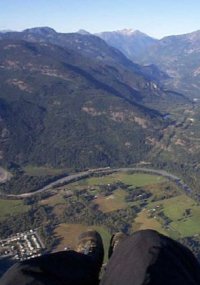
From the desk of:
Tom Tate
Dear
Friend,
If you want to fly but money is an issue then this page will help you.
I am going to show you how simple it is to get a Powered Paraglider quickly, and CHEAPLY in 8 simple steps.
Below is an exact step by step guide to getting your own Powered Paraglider. Even
if you decide not to build your own you will find a lot of this information helpful.
Step 1 Setting the Plan.
Print out this page. Write a written goal statement and plan for your self. This can be very simple. One that I used for myself was , "I Tom Tate am flying in my own aircraft before March 31st 1994. I will work on this goal a little bit every day till I achieve it." Writing a goal will help you to cement the importance of this goal in your unconscious and will insure that you achieve it.
Step 2 Getting your Glider
Start looking around at Paragliding and Powered Paragliding schools for a used canopy, harness and lessons. You will want to call several different schools.
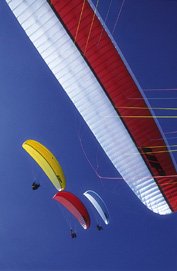 Paragliding schools are a good source for used canopies and harnesses just remember that they are not the only source. They may try to overcharge you but, they are very unlikely to sell you anything inherently unsafe or that would not work for what you are trying. They need a good reputation to stay in business. You should tell them how you are planning to use the canopy and ask their advice. You will find most instructors to be very helpful. The time of year that you purchase your canopy can make a big difference in the price. Some schools will sell their training canopies at very reasonable prices during the season when they are the least busy with lessons. You can find the names and addresses of many paragliding schools in any issue of HANGGLIDING or PARAGLIDING magazine.
Paragliding schools are a good source for used canopies and harnesses just remember that they are not the only source. They may try to overcharge you but, they are very unlikely to sell you anything inherently unsafe or that would not work for what you are trying. They need a good reputation to stay in business. You should tell them how you are planning to use the canopy and ask their advice. You will find most instructors to be very helpful. The time of year that you purchase your canopy can make a big difference in the price. Some schools will sell their training canopies at very reasonable prices during the season when they are the least busy with lessons. You can find the names and addresses of many paragliding schools in any issue of HANGGLIDING or PARAGLIDING magazine.
The more places that you look, call or contact, the more likely you are to find that really good deal. I have seen good canopies go for as little as $350 but $1300 is more common.
I am not going to try to list paragliding schools here, because there are simply too many and the list would be constantly changing. However, we do maintain a page with a partial list of schools that are on the web. EasyUps Schools List
This list is by no means complete and we suggest that you do more looking around in your local area. If you go to your local airport and ask around you will usually find someone who knows about a school somewhere. There are a lot of instructors out there who are just not yet net savvy.
Sometimes you can find a really good deal from an individual, a classified ad or from someone you meet in a club or even someone you meet at a paragliding school. Placing wanted ads has worked very well for some people. Ebay can be a source for deals but normally you will find better deals dealing direct with local individuals.
If you find a canopy from an individual you may want to take it to a paragliding school or instructor and have them inspect if for you. If you are taking lessons there or plan to take lessons with them they will generally inspect it for you for free.
Once you have your canopy you can practice Kiting. Kiting is when you inflate the canopy over your head and run around on a field. You do not take off from the ground at this stage but this practice will make your first take off a lot easier and make you a much more proficient pilot.
The reason that we list looking for canopies before getting lessons is that you never know when you may find the awesome deal on a canopy and you will sort of be looking for lessons and canopies at the same time.
Step 3 Getting your Training
While looking for canopies also be looking for lessons. If you buy a canopy from a school during their off season. (Right Now in most of the US) You may be able to negotiate getting a deal on lessons. They may even throw them in with the canopy at the same price. Talk to several. You will find that their methods and price vary GREATLY. If you do not like what the first one you call has to say just call the next one.
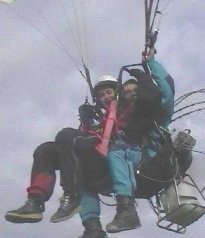 If you can not find a good local instructor you may have to take a weekend vacation trip. Anywhere in the US you can drive less then a day and be at a Paragliding school. If there are no good instructors in your immediate area then you may want to go into business as an instructor yourself after you have sufficient training and experience.
If you can not find a good local instructor you may have to take a weekend vacation trip. Anywhere in the US you can drive less then a day and be at a Paragliding school. If there are no good instructors in your immediate area then you may want to go into business as an instructor yourself after you have sufficient training and experience.
It would be possible to get your equipment and make your first flight with no more knowledge then what is in the book Going Up in a Parachute. DON'T DO THAT! There are several good reasons why we say this.
There is no substitute for a basic training course in Paragliding. this will only cost you a few hundred dollars but it will make you a safer pilot. It will save you a whole lot of time, money, frustration and heartache. It may even save your life and that is definitely worth more then a few hundred dollars. Some instructors will give you a taster sample of instruction for one day for less then 100 dollars. There are a lot of true stories about the strange things people without instruction have tried. A mere 100 dollars would have saved these people thousands in damaged equipment, time and hospital bills.
Step 4 Making Your Frame
Get your aluminum and cut it up as per the Plans. The Plans are all drawn either 100% or 50% to scale so they are very easy to read and understand. You can cut up your aluminum using simple hand tools.
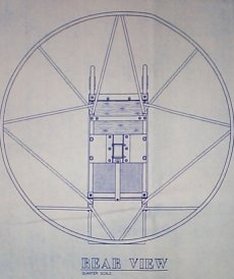 Boat manufacturers are a good source of inexpensive quality aluminum. They will usually have most of the stock that you need as scrap, and so sell it to you for a fair price by the pound. Next, try the metal supply houses in your area. They can usually be found in your local yellow pages. If you live in small town, you may have to order your stock from some place farther away. Especially the stock for the cage. AIRCRAFT SPRUCE SPECIALTY carries a wide range of aluminum stock, but they are probably not the least expensive way to go. The best aluminum alloy for Parapropter application is 6061-T6. If you want to know more about aluminum alloys, AIRCRAFT SPRUCE SPECIALTY has an excellent, detailed and easy-to-understand explanation of the various alloys in their catalog. Or you can check your local library. Just a note: I found the AIRCRAFT SPRUCE SPECIALTY catalog to be well worth the $5 it cost me, and they were willing to answer my questions when I was ordering stuff. To get one of their catalogs you can call 1 800 824 1930 in the U.S. or Canada. If outside these areas or if you are just asking them questions call 714 870 7551.
Boat manufacturers are a good source of inexpensive quality aluminum. They will usually have most of the stock that you need as scrap, and so sell it to you for a fair price by the pound. Next, try the metal supply houses in your area. They can usually be found in your local yellow pages. If you live in small town, you may have to order your stock from some place farther away. Especially the stock for the cage. AIRCRAFT SPRUCE SPECIALTY carries a wide range of aluminum stock, but they are probably not the least expensive way to go. The best aluminum alloy for Parapropter application is 6061-T6. If you want to know more about aluminum alloys, AIRCRAFT SPRUCE SPECIALTY has an excellent, detailed and easy-to-understand explanation of the various alloys in their catalog. Or you can check your local library. Just a note: I found the AIRCRAFT SPRUCE SPECIALTY catalog to be well worth the $5 it cost me, and they were willing to answer my questions when I was ordering stuff. To get one of their catalogs you can call 1 800 824 1930 in the U.S. or Canada. If outside these areas or if you are just asking them questions call 714 870 7551.
I just found another great source for aluminum at WWW.ONLINEMETALS.COM
After you have all the aluminum cut to the right sizes you will need to bolt and weld it together. "OH NO Not welding!" Don't worry. I can not weld either but nearly every boat shop has a certified aluminum welder.
So just take it to a boat shop. Most welders charge on an hourly rate of from $10 to $50 per hour with a minimum of around $20. If you cut, trim and fit all of the pieces before you go to the welder so that for them it is just like welding a puzzle with you placing the pieces, they will probably just charge you whatever their minimum is.
Don't go with anyone who grinds off all of their work, or has a lot of splatters and generally messy welds. Remember the welds must be smooth so that the canopy lines can slide past them.
If you don't have any boat shops locally (unlikely) you can look in the yellow pages for different kinds of metal shops that will have good certified aluminum welders. There are a lot of them.
Step 5 Getting your motor
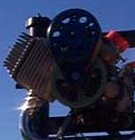 There are a lot of possible engines out there -- Zenoah, Solo, Cors-Airs etc. -- that will work just fine so long as you have an engine that matches the parameters listed in the technical section of the builders book that comes with the plans. The Parapropter was designed with a universal antivibration motor attachment plate to insure that people could use a variety of motors with it.
There are a lot of possible engines out there -- Zenoah, Solo, Cors-Airs etc. -- that will work just fine so long as you have an engine that matches the parameters listed in the technical section of the builders book that comes with the plans. The Parapropter was designed with a universal antivibration motor attachment plate to insure that people could use a variety of motors with it.
Used engines can come from a variety of sources;
- from companies who deal in used engines,
- from an individual off of other things, like motorcycles or snowmobiles (but if you are going to get an engine like this, you need a lot of mechanical knowledge and ability)
- from individuals who buy ultralight kits but never build them or once built they never fly them.
- But the best deals you will find will be from people who have wrecked fixed wing ultralights with the engines still intact. This is a surprisingly common occurrence. Ultralight clubs, newspaper advertisements and word of mouth are good sources. I have seen a wrecked ultralight with a perfectly good, nearly brand new engine for only $200. It can take time and patience to find a deal like that.
- A new motor will cost you between $500 and $3000
By looking at the frame you have just built and comparing it with the motor you are getting you will be able to see very quickly if it will fit or not. You can call a prop company to see if the motors RPM and Horsepower will support enough thrust to get you flying.
How much thrust you need to fly will depend on your weight and the size canopy you get but generally you are fine with anything over 100 pounds of thrust. I weigh 200 pounds and I flew from a beach on 80 pounds of thrust but it was a bit weak for me. The more thrust the better, within reason. You will probably never need more then 150 pounds of thrust.
Here are some general sources for used motors that I have found. Please remember while you will probably get better prices on your own these places can be sources of advice.
http://www.compactradialengines.com/sc430.htm
Perfect motor. Kind of spendy.
http://www.limflug.de/frameuk.htm
I do not know too much about them.
J-Bird Power Supplies - 1 262 626 2611 Lots of good used motors no web site.
There are lots of other sources. These are just some I recently found.
A quick note on propellers
 I would advise buying a new propeller if the engine you purchase does not already have one with it. Finding a used propeller that is the perfect match for your used engine may be very difficult. A used propeller may have hidden damage that can cause trouble.
A fairly good quality two-bladed wooden propeller can be purchased new for about $100 to $120 from a variety of companies.
I would advise buying a new propeller if the engine you purchase does not already have one with it. Finding a used propeller that is the perfect match for your used engine may be very difficult. A used propeller may have hidden damage that can cause trouble.
A fairly good quality two-bladed wooden propeller can be purchased new for about $100 to $120 from a variety of companies.
You can find ads for propeller companies in any issue of ULTRALIGHT FLYING magazine. To get the best deal you will have to call around. I found Ritz Propeller Company to be the cheapest by a few dollars. The first propeller they sent me was badly warped, and the exchange they sent me is not perfect but it works OK.
Step 7 Testing your Aircraft
You should do some tests on your craft before you attempt to fly it. Put it on. Start your engine. Now gradually run the throttle up to full while keeping in mind that you are checking to see if the push against your back is fairly straight, and that there is not too much vibration. Notice if there is any undue vibration.
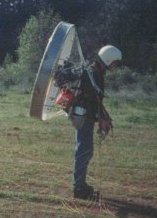 As far as the push being straight, what I mean is that the craft should not try to push itself around you, but rather try to push you forward. It will try to twist on your back in the opposite way that the propeller turns, pulling on one shoulder strap harder than on the other. This is not a problem, as the effect will be much less noticeable when flying.
As far as the push being straight, what I mean is that the craft should not try to push itself around you, but rather try to push you forward. It will try to twist on your back in the opposite way that the propeller turns, pulling on one shoulder strap harder than on the other. This is not a problem, as the effect will be much less noticeable when flying.
You must be very careful, and all of those around you must be very careful, whenever the propeller is turning. You must consider it a moving Disk of Death and anything that enters into this disk will be utterly destroyed; like hands, elbows, cats, etc. ... It will also be uncomfortable for the wearer if it contacts something inanimate like a branch or fence post.
Note; It should be doing what it was designed to do -- push or move the entire assembly -- so keep in mind that the Disk of Death can and will move of its own volition. If the motor is running make sure you have control of it. I know of a guy who started a motor unit similar the Parapropter and left it idling on a park bench. Of course it blew itself off the bench and destroyed itself. Luckily no one was hurt.
Once you have the engine running and on your back it is a good time to test the engine's thrust. Here is a very simple, cheap, easy and not entirely accurate way do this: Get a simple spring-powered scale like a typical bathroom scale. Stand about arms-length from a tree or pole (a large pole like a telephone or power pole). Place the scale against the pole and hold it with your palms -- arms outstretched -- then run the throttle to full and look at the scale. A wall will not work as well as a pole because you get odd airflows near a wall. It takes about 50 pounds of thrust to maintain level flight, so you obviously need more than this to actually fly. You should fly fine with anything over 100 pounds of thrust I do not currently know of any backpack units putting out much more than 150 pounds of thrust.
Put on the harness, then put on the power unit and hook the harness to the power unit. Walk and hop around like this a little bit to make sure that you are comfortable. Next you will have to find something that you can safely hang from -- like a strong beam, a swing set minus the swings, or a gazebo in a park.
Tie two ropes to your beam -- spread slightly to mimic the angle of pull from the canopy. While it's still on your back, tie the unit to these ropes and bend your knees. This is basically how it is going to feel when flying. Squirm around a lot. Pull yourself into the seat, then out into landing or take-off position, back and forth repeatedly.
Once you think that you have things basically worked out, start the engine. But first check to see that no loose rope ends will be sucked into the propeller, and that no one is too close. Play around a little. Run the power up and down. Squirm in and out of the seat under full power and half power. Check for comfort when just sitting there under full power. Try not get yourself swinging too hard, and if you do, just put your feet down.
After you have done your hanging check with power, examine the whole craft in minute detail Check you fuel system for looseness, heat damage or leaks. Check your vibration mounts. Check to see if your spark plug wires stayed tight. Check your prop bolts to see if they have pulled tight against the safety wire. Check the propeller to see that it did not nick the cage or develop any defects like cracks.
Step 8 Your First flight
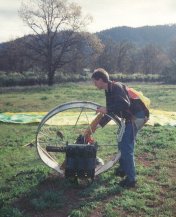 First, before you fly a Parapropter, you need to have a good understanding of how to work with your paraglider. Once you can land, take off -- and especially kite -- your paraglider proficiently, flying your Parapropter will be a breeze. Being good at kiting your canopy is important for being able to take off easily in a Parapropter. For this reason, and for safety, it is so very important to take paragliding lessons.
First, before you fly a Parapropter, you need to have a good understanding of how to work with your paraglider. Once you can land, take off -- and especially kite -- your paraglider proficiently, flying your Parapropter will be a breeze. Being good at kiting your canopy is important for being able to take off easily in a Parapropter. For this reason, and for safety, it is so very important to take paragliding lessons.
Reread FAR part 103, and make sure that the field you choose for your maiden flight is not in or near controlled airspace.
At least for your maiden flight, choose an extremely large field that is relatively free of tall nearby objects, even if you have to drive some distance from your home. You can always fly nearer to your home from smaller fields later.
Bring some friends or family members who you have no need to impress. (true friends) They can help you set up and make sure everything goes smoothly.
Pick a day and time when conditions are nearly dead calm. It is usually calmest at the crack of dawn.
Lay out your canopy in the take-off position, especially making sure that all of your lines are straight and are not snagged on any sticks or weeds. Put on your harness, and helmet. Put on your Parapropter and start it. Warm it up. Run it up to full throttle to make sure that everything feels OK, just like your test did. Hook the canopy to the correct places on your Parapropter.
You are ready to fly.
 Now, with the engine at idle, inflate the canopy as you were taught in paragliding school. Note: You must remember to keep the engine at idle, because the air going back from it is too turbulent for proper inflation of the canopy. Check to make sure that the canopy is directly overhead and that everything is right with it (no lineovers, endcell closures, etc. ...). Give the engine full throttle and run forward as fast as you can. Do not try to jump into the air, as this will release pressure on the canopy and keep you from flying. After a few steps you will find that your feet are barely touching, then that they are not touching at all.
Now, with the engine at idle, inflate the canopy as you were taught in paragliding school. Note: You must remember to keep the engine at idle, because the air going back from it is too turbulent for proper inflation of the canopy. Check to make sure that the canopy is directly overhead and that everything is right with it (no lineovers, endcell closures, etc. ...). Give the engine full throttle and run forward as fast as you can. Do not try to jump into the air, as this will release pressure on the canopy and keep you from flying. After a few steps you will find that your feet are barely touching, then that they are not touching at all.
You are flying!!!
Enjoy the overwhelming sense of accomplishment and joy of flying your own aircraft.
You have joined a very elite group of less then one percent of the worlds population. You are now a pilot! You have built and flown your own aircraft. You can feel very good about that. It is quite an accomplishment.

YOU CAN NOW FLY WHENEVER YOU WANT!
Enjoy!
Tom Tate - President
EasyUp
|



